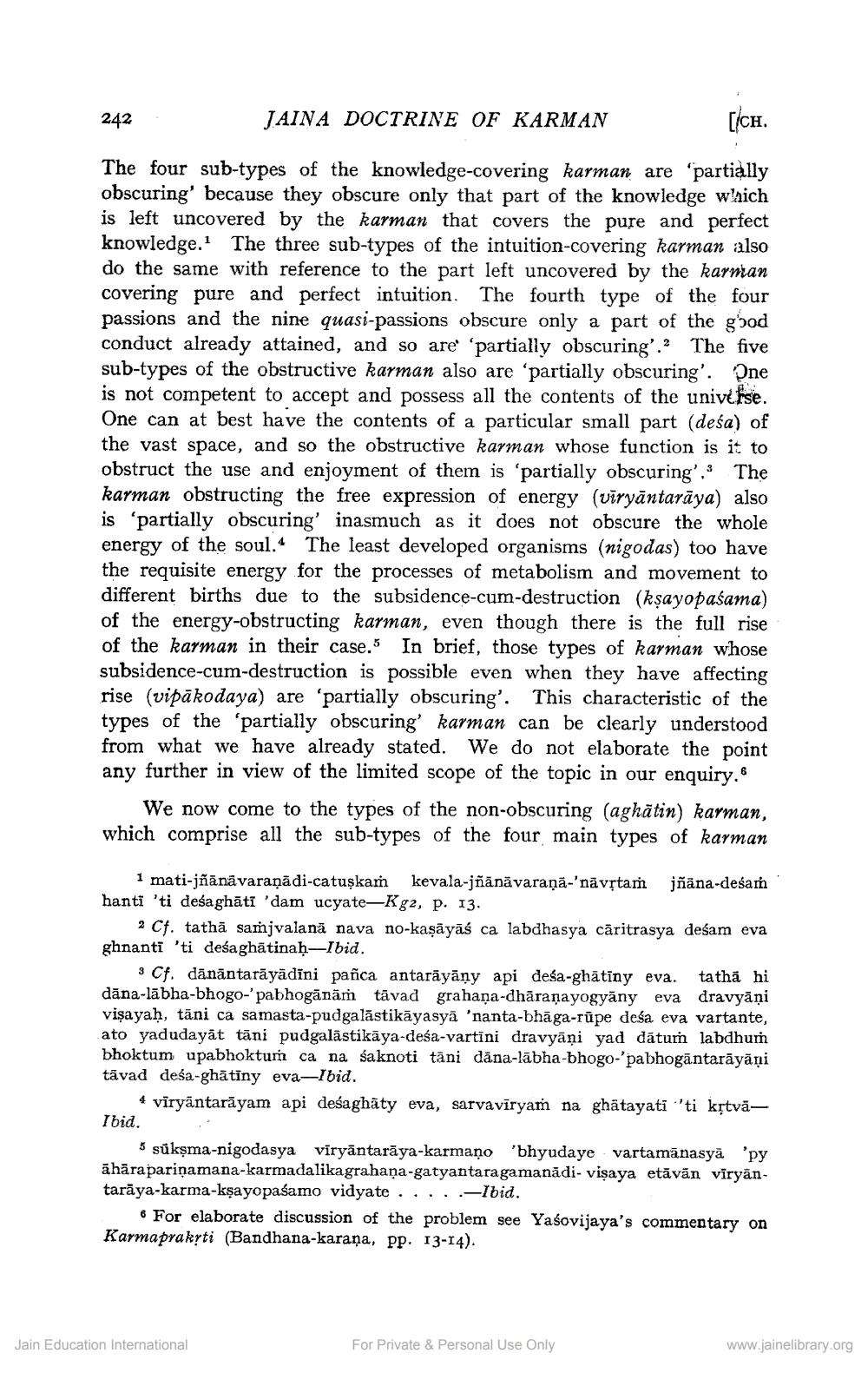________________
JAINA DOCTRINE OF KARMAN
[/сн.
The four sub-types of the knowledge-covering karman are 'partially obscuring' because they obscure only that part of the knowledge which is left uncovered by the karman that covers the pure and perfect knowledge. The three sub-types of the intuition-covering karman also do the same with reference to the part left uncovered by the karman covering pure and perfect intuition. The fourth type of the four passions and the nine quasi-passions obscure only a part of the good conduct already attained, and so are 'partially obscuring'. The five sub-types of the obstructive karman also are 'partially obscuring'. One is not competent to accept and possess all the contents of the universe. One can at best have the contents of a particular small part (desa) of the vast space, and so the obstructive karman whose function is it to obstruct the use and enjoyment of them is 'partially obscuring'.3 The karman obstructing the free expression of energy (viryāntarāya) also is 'partially obscuring' inasmuch as it does not obscure the whole energy of the soul. The least developed organisms (nigodas) too have the requisite energy for the processes of metabolism and movement to different births due to the subsidence-cum-destruction (kṣayopasama) of the energy-obstructing karman, even though there is the full rise of the karman in their case. In brief, those types of karman whose subsidence-cum-destruction is possible even when they have affecting rise (vipakodaya) are 'partially obscuring'. This characteristic of the types of the 'partially obscuring' karman can be clearly understood from what we have already stated. We do not elaborate the point any further in view of the limited scope of the topic in our enquiry."
242
We now come to the types of the non-obscuring (aghatin) karman, which comprise all the sub-types of the four main types of karman
jñāna-deśaṁ
1 mati-jñānāvaraṇādi-catuṣkam hanti 'ti deśaghātī 'dam ucyate-Kg2, p. 13.
2 Cf. tatha samjvalanä nava no-kaṣāyāś ca labdhasya caritrasya deśam eva ghnanti 'ti deśaghatinaḥ-Ibid.
kevala-jñānā varaṇā-'nāvṛtam
3 Cf. danāntarāyādīni pañca antarāyāṇy api deśa-ghatiny eva. tatha hi dāna-labha-bhogo-'pabhogānāṁ tavad grahaṇa-dharaṇayogyany eva dravyāṇi viṣayaḥ, tāni ca samasta-pudgalāstikāyasya 'nanta-bhāga-rupe deśa eva vartante, ato yadudayat tani pudgalastikāya-deśa-vartini dravyāņi yad datum labdhum bhoktum upabhoktum ca na śaknoti tani dana-labha-bhogo-'pabhogāntarāyāņi tāvad deśa-ghatiny eva-Ibid.
4 viryāntarāyam api deśaghaty eva, sarvaviryam na ghatayati ''ti kṛtvā
Ibid.
5 sükṣma-nigodasya viryāntarāya-karmano 'bhyudaye vartamānasya 'py ähärapariņamana-karmadalikagrahana-gatyantaragamanadi- viṣaya etävän viryäntaraya-karma-kṣayopaśamo vidyate. .
-Ibid.
• For elaborate discussion of the problem see Yaśovijaya's commentary on Karmaprakyti (Bandhana-karana, pp. 13-14).
Jain Education International
For Private & Personal Use Only
www.jainelibrary.org




